This Respiratory Protection policy provides standards for the selection, use and care of respiratory protection equipment necessary for the protection of the life and health of associates when working in oxygen deficient or contaminated atmospheres.
This program is to be administered and evaluated by the EHS Risk Mitigation Manager.
It is Yaskawa America, Inc.’s policy that no associate shall work in IDHL (Immediately Dangerous to Health or Life) atmospheres.
All respirators are to be NIOSH certified and selected based on the hazards the worker is exposed to.
An oxygen deficient atmosphere contains less than 19.5% oxygen.
It is Yaskawa America, Inc.’s policy that no associate shall work in an oxygen deficient atmosphere.
Harmful contaminants are in the atmosphere may be gaseous or particulate. Gas and vapor contaminates can be asphyxiates, anesthetics, irritants or poisons.
Particulate matter, which is a suspension of fine solid or liquid particles in the air, can be an irritant or can be toxic.
Atmospheric testing by a qualified person, using approved, calibrated instrumentation is required to evaluate respiratory hazards and should be conducted before personnel enter any confined location or area where contaminants can be expected to be present.
Warning signs such as dizziness, headache, coughing, sneezing, nausea, eye or skin irritation or loss of feeling may be observed in a work area.
If testing confirms the presence of respiratory hazards, ventilation must be provided and personnel instructed to leave the area until respiratory protection is in place.
Respiratory protective devices are provided by the company at no expense to the employee. Respiratory protective devices consist of air purifying, supplied air, and self‐contained breathing (SCBA) apparatus.
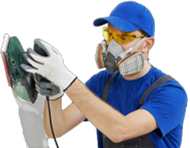
Mechanical filter respirators offer respiratory protection against airborne particulate matter including dusts, mists, metal fumes and smoke.
Mechanical filter respirators do not protect against gases, vapors or oxygen deficiency.
Chemical Cartridge Filter
Chemical cartridge respirators are non‐emergency respiratory protective devices which provide protection against light concentrations (.1% by volume) of certain acid gases, alkaline gases, organic vapors and mercury vapors.
Do not use chemical cartridge respirators for protection against highly toxic gases, gases which cannot be easily detected by odor before hazardous concentration is reached, gases which irritate the eyes, or on gases which are not stopped by the respirator elements.
Combination Filter
Combination chemical cartridge and mechanical filter respirators utilize filters to trap dust, mist or fumes, and a chemical cartridge to remove gases or vapors from the atmosphere. These combination devices are not to be used for oxygen deficiency or for protection against highly toxic gases.
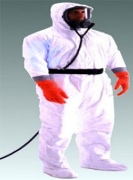
Air line respirators are approved for use only in atmospheres not immediately harmful to life.
The user is fully dependent upon an air supply not carried by the user; the air supply hose limits distance and confines the use to one path for entry and exit.
An air line respirator is connected to a suitable compressed air source equipped with pressure regulators, pressure relief valves, and air filters to insure proper pressure and air quality.
Pressure should be 10‐15 psig, with relief valves set at 16psig.
Air quality must meet Compressed Gas Association Specification G7.1 for Type 1, Class D gaseous air.
Air line connectors must be Schraeder Quick Connects to avoid hook up with improper air supply.
Air Line Respirators may be equipped with a full face mask, with or without a welder’s adapter, a half mask designed for use under a welding helmet, or an air supplied hood.

Air packs, a self contained breathing apparatus (SCB A) are approved for use in oxygen deficient atmospheres and hazardous concentrations of toxic gases.
These units provide a high rate of flow to meet breathing demands even during extreme exertion.
Normal capacity is a 30 minute supply but, depending on breathing demand, air supply may only last 15 or 20 minutes.
An audible alarm signals low air supply.
Medical examinations shall be required for any associate prior to assignment to any job which requires use of a respirator.
No associate with respiratory disease or other medical limitations will be allowed to perform work in areas requiring the use of respiratory equipment.
All medical evaluations will be confidential, during normal work hours, convenient, understandable and the associate will be given the opportunity to discuss the results with the examining physician or health care provider.
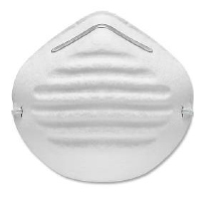
A medical evaluation is not required for voluntary use of a dust mask (e.g.: N95, KN95).
IMPORTANT: When associates voluntarily wear a dust mask, such as an N95, the associate must be provided with a copy of Appendix D of the Respiratory Protection Standard (29 CFR 1910.134).
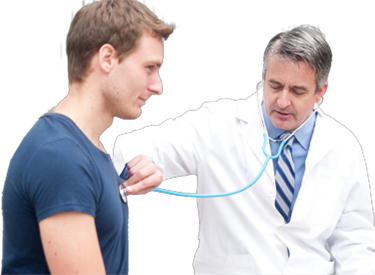
Training and education in respiratory protection selection, use and maintenance shall be provided by a competent instructor initially and annually to supervisors and workers who use respirators, prior to use of the equipment.
Minimum instruction requirements are:
Face piece fit tests and procedures by qualitative or quantitative methods shall be included in the training for each user. Respirators shall not be worn when conditions prevent a good face seal. Such conditions may be a growth of beard, sideburns, or temple pieces of eyeglasses. The absence of dentures can also affect the fit of a face piece.
To assure proper protection, the face piece fit shall be checked by the wearer prior to each use. This may be done as follows:
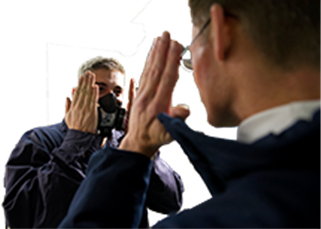
Positive Pressure Test
Corrective lenses may be worn with a half mask if they do not affect the fit of the face piece.
Corrective lenses with a full mask prohibit a proper seal if the temple bards of the glasses extend through the sealing edge of the mask.
As a temporary measure, glasses with short temple bars or without temple bars may be taped to the wearer’s head.
Contact lenses are prohibited because they may dislodge and block the discharge valve or regulator.
Respirator use in low temperatures can cause poor visibility and freezing of exhalation valves in full face pieces.
Anti‐fog compounds can be used on the inside of the lend to prevent fogging at room temperature down to about 32˚ F.
Full face pieces with nose cups the direct warm, moist exhaled air through the exhalation valve should provide adequate defogging to ‐30˚ F.
Dry respirable air shall be used with SCBA and airline respirators with dew point appropriate to the ambient temperature.
High pressure connections on SCBA may leak due to metal contraction at low temperature. Do not over tighten or the connections may break when temperatures rise to normal.
Respirator use in high temperatures increase stress experienced by the wearer of a respirator. Cooled breathing air is recommended.
Communication by speech is restricted and distorted by conventional respirators. Talking can induce face piece or component leakage and should be limited.
Some respirators are equipped with speaking diaphragms which also act as a barrier to the ambient atmosphere.
A puncture in this diaphragm destroys its protective ability; therefore, it should be protected by a cover.
Respirator inspections shall include a check of sanitation and cleanliness, the tightness of connections and the condition of the face piece, headbands, valves, connecting tubes and canisters.
Rubber or elastomeric parts shall be inspected for pliability and signs of deterioration. Stretching and massaging the rubber or elastomeric parts will keep them pliable.
All respirators shall be inspected by the user before and after each use.
Self-contained breathing apparatus shall also be inspected monthly. Cylinders shall be fully charged according to the manufacturer’s specifications. Regulators and warning devices must function properly.
Respirators stored for emergency use shall be inspected after each use, and at least once a month, to insure their reliability. The cost center manager shall notify the EHS Risk Mitigation Manager when an emergency respirator has been used.
Medical evaluations shall be maintained by Human Resources.
General Respiratory Protection training is included in the Safety Orientation Training Program and included in periodic refresher training.
Training for associates using respirators, except dust masks for voluntary use, are maintained by the affected associates manager.
| Rev # | Description | Release Date | Approved by |
|---|---|---|---|
| 0 | Conversion of old safety documents, rewrite, and issue | 9/12/2016 | Thurwanger |
| Review Date | Reviewed by | Changes Required (Yes/No) | Revision # if updated |
|---|---|---|---|
| 2/21/2017 | Thurwanger | No | |
| 1/16/2018 | Thurwanger | No | |
| 1/22/2019 | Thurwanger | No | |
| 1/14/2020 | Thurwanger | No | |
| 1/21/2021 | Thurwanger | No | |
| 1/18/2022 | Thurwanger | No | |
| 1/31/2023 | Thurwanger | No | |
| 1/16/2024 | Thurwanger | No | |
| 1/21/2025 | Thurwanger | No | |
Policy Video
